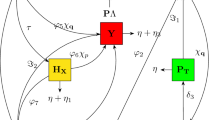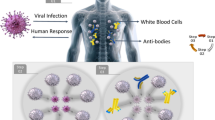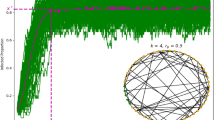Abstract
The spreading of contagions can exhibit a percolation transition, which separates transitory prevalence from outbreaks that reach a finite fraction of the population1,2. Such transitions are commonly believed to be continuous, but empirical studies have shown more violent spreading modes when the participating agents are not limited to one type. Striking examples include the co-epidemic of the Spanish flu and pneumonia that occurred in 1918 (refs 3, 4), and, more recently, the concurrent prevalence of HIV/AIDS and a host of diseases5,6,7. It remains unclear to what extent an outbreak in the presence of interacting pathogens differs from that due to an ordinary single-agent process. Here we study a mechanistic model for understanding contagion processes involving inter-agent cooperation. Our stochastic simulations reveal the possible emergence of a massive avalanche-like outbreak right at the threshold, which is manifested as a discontinuous phase transition. Such an abrupt change arises only if the underlying network topology supports a bottleneck for cascaded mutual infections. Surprisingly, all these discontinuous transitions are accompanied by non-trivial critical behaviours, presenting a rare case of hybrid transition8. The findings may imply the origin of catastrophic occurrences in many realistic systems, from co-epidemics to financial contagions9.
This is a preview of subscription content, access via your institution
Access options
Subscribe to this journal
Receive 12 print issues and online access
$259.00 per year
only $21.58 per issue
Buy this article
- Purchase on SpringerLink
- Instant access to full article PDF
Prices may be subject to local taxes which are calculated during checkout




Similar content being viewed by others
References
Stauffer, D. & Aharony, A. Introduction to Percolation Theory (Taylor & Francis, 1994).
Newman, M. Networks: An Introduction (Oxford Univ. Press, 2010).
Brundage, J. F. & Shanks, G. D. Deaths from bacterial pneumonia during 1918–19 influenza pandemic. Emerg. Infect. Dis. 14, 1193–1199 (2008).
Taubenberger, J. & Morens, D. 1918 Influenza: The mother of all pandemics. Emerg. Infect. Dis. 12, 15–22 (2006).
Pawlowski, A., Jansson, M., Skold, M., Rottenberg, M. E. & Kallenius, G. Tuberculosis and HIV co-infection. PLoS Pathogens 8, e1002464 (2012).
Chang, C. C. et al. HIV and co-infections. Immun. Rev. 254, 114–142 (2013).
Petney, T. & Andrews, R. Multiparasite communities in animals and humans: Frequency, structure and pathogenic significance. Int. J. Parasitol. 28, 377–393 (1998).
Goltsev, A. V., Dorogovtsev, S. N. & Mendes, J. K-core (bootstrap) percolation on complex networks: Critical phenomena and nonlocal effects. Phys. Rev. E 73, 056101 (2006).
Claessens, S. & Forbes, K. (eds) International Financial Contagion: An Overview of the Issues (Springer, 2009).
Davis, S., Trapman, P., Leirs, H., Begon, M. & Heesterbeek, J. The abundance threshold for plague as a critical percolation phenomenon. Nature 454, 634–637 (2008).
Wang, P., González, M. C., Hidalgo, C. A. & Barabási, A. L. Understanding the spreading patterns of mobile phone viruses. Science 324, 1071–1076 (2009).
Barrat, A., Barthelemy, M. & Vespignani, A. Dynamical Processes on Complex Networks (Cambridge Univ. Press, 2008).
Buldyrev, S. V., Parshani, R., Paul, G., Stanley, H. E. & Havlin, S. Catastrophic cascade of failures in interdependent networks. Nature 464, 1025–1028 (2010).
Gao, J., Buldyrev, S. V., Stanley, H. E. & Havlin, S. Networks formed from interdependent networks. Nature Phys. 8, 40–48 (2012).
Li, D. et al. Percolation transition in dynamical traffic network with evolving critical bottlenecks. Proc. Natl Acad. Sci. USA 112, 669–672 (2014).
Dodds, P. S. & Watts, D. J. Universal behavior in a generalized model of contagion. Phys. Rev. Lett. 92, 218701 (2004).
Pruppacher, H., Klett, J. & Wang, P. Microphysics of Clouds and Precipitation (Taylor & Francis, 1998).
Ma, S. K. Modern Theory of Critical Phenomena (Westview Press, 2000).
Watts, D. J. & Strogatz, S. H. Collective dynamics of “small-world” networks. Nature 393, 440–442 (1998).
Newman, M. E. J. & Watts, D. J. Scaling and percolation in the small-world network model. Phys. Rev. E 60, 7332–7342 (1999).
Janssen, H.-K., Müller, M. & Stenull, O. Generalized epidemic process and tricritical dynamic percolation. Phys. Rev. E 70, 026114 (2004).
Barabási, A. L. & Albert, R. Emergence of scaling in random networks. Science 286, 509–512 (1999).
Parshani, R., Buldyrev, S. V. & Havlin, S. Interdependent networks: Reducing the coupling strength leads to a change from a first to second order percolation transition. Phys. Rev. Lett. 105, 048701 (2010).
Achlioptas, D., D’Souza, R. M. & Spencer, J. Explosive percolation in random networks. Science 323, 1453–1455 (2009).
da Costa, R. A., Dorogovtsev, S. N., Goltsev, A. V. & Mendes, J. F. F. Explosive percolation transition is actually continuous. Phys. Rev. Lett. 105, 255701 (2010).
Riordan, O. & Warnke, L. Explosive percolation is continuous. Science 333, 322–324 (2011).
Grassberger, P., Christensen, C., Bizhani, G., Son, S. W. & Paczuski, M. Explosive percolation is continuous, but with unusual finite size behavior. Phys. Rev. Lett. 106, 225701 (2011).
Araújo, N. A. M. & Herrmann, H. J. Explosive percolation via control of the largest cluster. Phys. Rev. Lett. 105, 035701 (2010).
Axelrod, R. The Evolution of Cooperation (Basic Books, 1984).
Suri, S. & Watts, D. Cooperation and contagion in web-based, networked public goods experiments. PLoS ONE 6, e16836 (2011).
Acknowledgements
We thank D. Brockmann and W. Nadler for discussions.
Author information
Authors and Affiliations
Contributions
All authors conceived and designed the research, carried out numerical experiments, analysed the data, worked out the mechanism and wrote the manuscript.
Corresponding author
Ethics declarations
Competing interests
The authors declare no competing financial interests.
Supplementary information
Supplementary information
Supplementary information (PDF 1978 kb)
Rights and permissions
About this article
Cite this article
Cai, W., Chen, L., Ghanbarnejad, F. et al. Avalanche outbreaks emerging in cooperative contagions. Nature Phys 11, 936–940 (2015). https://doi.org/10.1038/nphys3457
Received:
Accepted:
Published:
Issue date:
DOI: https://doi.org/10.1038/nphys3457
This article is cited by
-
Infection-induced cascading failures – impact and mitigation
Communications Physics (2024)
-
Multiscale cooperative micro-excitations and structural rearrangements in cold dusty plasma liquids
Reviews of Modern Plasma Physics (2021)
-
Particle velocity controls phase transitions in contagion dynamics
Scientific Reports (2019)
-
Local floods induce large-scale abrupt failures of road networks
Nature Communications (2019)
-
Fundamental ingredients for discontinuous phase transitions in the inertial majority vote model
Scientific Reports (2018)



